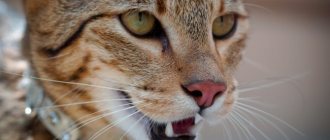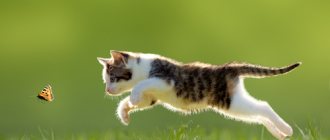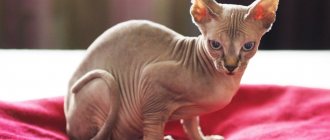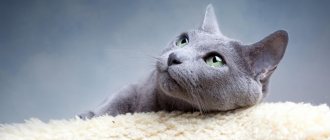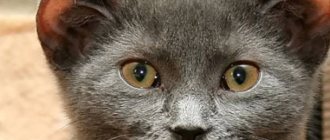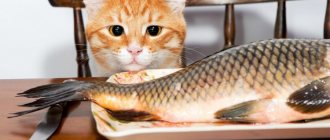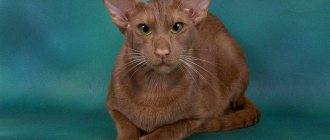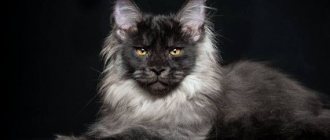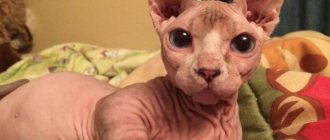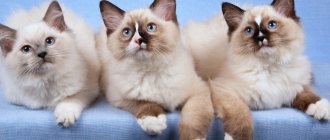Almost a third of people who have pets keep cats. In order to be able to choose the right pet, care for the pet and train it, many begin to get acquainted with the science called felinology. From Latin this word is translated as “the science of cats.” This section of zoology studies the anatomical structure, features of breeding and keeping cats of various breeds. By studying felinology, the owner of the animal will be able to learn more about the properties of the breed: health characteristics, some character traits and the intricacies of caring for a pet.
History of the profession
The first mention of felinology can be dated back to the end of the 19th century. On July 13, 1871, the world's first cat exhibition took place in London, organized by animal artist Grayson Weir. 170 cats of various breeds took part in it, and Weir himself was among the judges. This event marked the beginning of the emergence of the first breed standards. Then communities of cat lovers began to appear throughout the UK, and later throughout the world. In 1887, the world's first club for lovers of these animals, called the National cat club, was organized. It still exists today. In 1910, the felinological association of clubs GCCF (Governing Council of the Cat Fancy) appeared.
In 2002, for the first time in Russia, the opportunity arose to officially obtain higher education in the field of felinology at the Moscow Agricultural Academy named after. K. A. Timiryazeva.
Worship of cats in Ancient Egypt - interesting facts
Hobby or profession?
Let's figure out what their occupation is for felinologists: a hobby or a job.
From a generally accepted point of view, a profession is what a person does during his main working hours, and a hobby is an interest in his free time. A profession brings income, but a hobby requires financial investment. Professional pursuits require effort, in some ways even forcing yourself, in order to achieve some success. A hobby is for the soul, and, as a rule, a person does not strive to achieve any heights on purpose, everything turns out by itself.
Did you know?
Iodine was invented thanks to a cat who jumped on a table and knocked over test tubes.
Animal scientists conduct research during working hours and receive a salary for this. To become a livestock specialist, you need to study at a university for 5 years. To conduct research you need good laboratory equipment, which cannot be purchased with personal savings. Based on this, a livestock specialist is a profession.
If we consider breeders, caring for and breeding cats requires not only working time, but also non-working time.
Selling purebred kittens brings real money, but for this you need to want to buy kittens for that kind of money. This means investing money in a purebred mom and dad, feeding them with expensive food and vitamins, washing them with expensive shampoos, vaccinating them, taking them to the veterinarian, filling out documents, taking them to exhibitions, paying fees, and receiving awards. To these expenses you need to add the possible birth of rejected kittens, their death, and the death of the cat.
To register a nursery, you need to run around with paperwork and complete courses. At the same time, we can say that a person who does not like cats will not be able to pay so much attention to them and spend money on them. Therefore, being a breeder is both a hobby and a profession at the same time.
The expert has working hours during which he evaluates cats, for which he receives a salary and has the opportunity to travel around the world for free. To become an expert, a person has to study for a long time, study the intricacies of breed standards.
At the same time, the man was a breeder for a long time, devoting both working and non-working time to breeding, he invested a lot of money and effort in his training, he simply cannot help but love cats. This means that an expert combines both a profession and a hobby.
Important!
Felinologist is a profession that requires a creative approach, passion, financial expenses and complete immersion in the matter.
So, there are people who have turned the love of cats into a separate science that studies them, and we found out what it is called. Felinology is a special branch of science
. If you want to do it, you need to truly love cats, understand your responsibility to them, have a desire to develop in terms of accumulating knowledge, and develop memory. To become a felinologist, you need to turn your hobby into a profession.
Felinologist
- Domestic cat specialist.
Variety of felinology profiles
Despite the fact that all felinologists study cats and have knowledge in the field of zoology and selection, there is a clear structure of profiles among specialists:
Anyone who decides to engage in this science must receive an appropriate education.
Evaluation of purebred cats
To determine whether an animal corresponds to the breeding properties of a breed, there are certain requirements that were established by experts in the process of development of felinology and selection of cats. These requirements are otherwise called “breed standard”. Thanks to the work of felinologists, there are many unique breeds, the purity of which is maintained and carefully monitored at exhibitions and in scientific institutes.
The main characteristics of the formed breed:
- all animals are descended from a limited number of ancestors;
- cats have similar physiological characteristics (tail length, eye color, sounds made, etc.);
- there is a large population obtained without inbreeding;
- the points at which the breed reproduces and spreads differ according to a number of climatic and geographical conditions;
- The traits characteristic of a given cat population are stable and inherited.
Feline associations located in different parts of the world differ greatly in the way they check the suitability of cats for a particular breed. But all of them can be divided into two groups: the first carry out their work according to the European judging system, the second - according to the American one.
The European system involves a closed assessment procedure.
The experts are in a separate room, where neither spectators nor even the cat owners themselves are allowed. After judging, animal breeders are given special evaluation sheets signed by the judges.
In the American system, a whole show is played out of determining whether an animal matches the breeding properties of the breed. It brings together cat owners and spectators. In public view, experts examine and check each animal for compliance with the breed, studying its appearance and behavior.
If at least part of the points of the standard are not observed or described incorrectly, there is a risk of inhibiting the development of the breed or even its disappearance.
Almost a third of people who have pets keep cats. In order to be able to choose the right pet, care for the pet and train it, many begin to get acquainted with the science called felinology. From Latin this word is translated as “the science of cats.”
This section of zoology studies the anatomical structure, features of breeding and keeping cats of various breeds. By studying felinology, the owner of the animal will be able to learn more about the properties of the breed: health characteristics, some character traits and the intricacies of caring for a pet.
Cat lovers of all countries – unite! Part I
Cat lovers, let’s unite and be friends, but not “against” but “for”. “In force”, not “in spite of”.
Felinology (felinus) is the science of cats, studying domestic cats (anatomy and physiology) and their breeds, as well as selection issues, breeding and maintenance features.
The world's first cat lovers club, the National Cat Club, was registered in 1887 by Harrison Weir, who also became its president. On July 17, 1871, Harrison Weir organized the first specialized exhibition of purebred cats. Thanks to this exhibition, the first cat breed standards appeared. Then other similar clubs were created in England, now they are united in the British organization of cat lovers GCCF (Governing Council Cat Fancy), which has more than 50 regional clubs.
Cat lovers' clubs quickly gained popularity and appreciation and spread throughout the American continent. In 1906, the American Cat Association CFA (Cat Fanciers Association) appeared, which united more than 300 clubs. In 1922, the club appeared in Germany in the city of Nuremberg, and in 1926, the Paris Cat Lovers Club was organized in France.
World felinological organizations and associations of cat lovers differ significantly from each other, but they have the same goal - the development and improvement of standards for cat breeds and colors; establishing a system for holding exhibitions and requirements for their organization; control of the work of nurseries and cat clubs.
All modern felinological organizations can be divided into those working according to the European and American judging systems.
The European felinological system, as a rule, unites clubs of cat lovers. Judging according to the European system is closed; experts evaluating animals are in a separate room, where cat owners are not allowed. Spectators also cannot be present during the sacrament of judging! After the examination, the owners of the participating cats are given evaluation sheets signed by the judges.
The Americans came up with their own cat rating system, which, of course, differs significantly from the European one. The American felinological system directly unites the owners of nurseries. The Americans organize a whole show, a performance, gather a large number of spectators and evaluate the cats.
Many of the world's largest felinological organizations meet twice a year at the World Cats Congress (WCC) to agree on general provisions without changing their own policies or invading others.
WCF - World Cat Federation, World Federation of Cat Fanciers.
This is the largest felinological organization in the world, which today has more than 540 clubs from 18 countries. WCF was created in 1988 by Anneliese Hackman, who is its president. The main office of the federation is located in Germany in the city of Essen, and there are member organizations in Russia, Ukraine, Belarus, Germany, Italy, Poland and many other countries. This organization is the most popular in Russia.
Judging in the WCF takes place according to the European style. The system for winning titles at WCF exhibitions is quite complex. To obtain them, the owner and his pet have to travel a lot not only to cities, but also to other countries. For example, to obtain the title of world champion, you must achieve three top marks in two different continents or parts of the world. The final “BestinShow” competitions held by the federation are held openly and are extremely popular.
We suggest you read: Why does a cat eat poorly and lose weight?
FIFe- Federation International Feline, International Felinological Organization.
It was founded by Marguerite Ravel (France) in 1949 and was first called the United Nations Organization of the Cat Fancy. This organization includes owners and breeders of purebred cats from more than 27 countries. The main task of the newly created association was to regulate and stabilize spontaneous breeding of cats, streamline breeds and their standards, create uniform rules regarding exhibitions, names of nurseries, and training of judges.
In 1981, the organization was registered in Geneva under its current name, Federation Internationale Feline (FIFe). Now its main office is located in Luxembourg.
The main legislative body of the organization, the General Assembly, was created on December 10, 1950 in Belgium. The Assembly developed and established the Charter and Rules of the organization, which can be changed and finalized at the annual meetings of the Assembly. The FIFe structure guarantees equal rights for all its members.
CFA - The Cat Fanciers Association, Cat Fanciers Association.
This organization was created in the USA in 1906, but was officially registered only in 1919. The CFA includes clubs located in the USA, Canada and several other countries. In this organization (as in FIFe), the rule is one country - one club (or association of clubs).
All cats participating in CFA shows are entered into a computer program, which forms a single file of pedigrees and exhibition results; all CFA judges are licensed. Judging takes place according to the American felinological system: openly and does not involve any descriptions.
CFA is famous for the exceptional representatives of its recognized breeds, the list of which is very organic. Registration of cats is carried out according to strict rules, therefore it guarantees the absolute purity of the breed. This is the largest registry of pedigree cats in the United States.
We present a selection of the most interesting, funny and strange scientific studies about cats and cats, domestic and not so, as well as about the people around them.
Domestic cats have been accompanying humans for several millennia, and, according to scientists, today they are found everywhere where there is at least some hint of civilization. Of course, these same scientists are also people, and many of them, in search of an object to apply their scientific talents, turned to their beloved pets.
Flying cats It is probably not surprising that scientists are primarily interested in the amazing ability of cats to land on their paws when falling from any height. It is believed that the official history of scientific research in the field of falling kitten physics began in 1969, when two physicists from Stanford University published a study entitled “A Dynamical Explanation of the Falling Cat Phenomenon.”
At the same time, physicists, unlike their many followers, did not drop a single cat during their work. Instead, they created a mathematical abstraction, a cat model, that fairly well described the process and results of the fall of live cats that had once been abandoned by someone else. To this day, the article by Kane and Sher remains perhaps the only publication about cats in the International Journal of Solids and Structures.
Not all physicists believe that cats need to be thrown from a height; some are also interested in the characteristic manner of animals sneaking, carefully lying in wait for prey. For their study of sneaking cats, Christine Bishop from the University of California at Davis (USA) and her colleagues partially shaved three of them and painted them with special paint that helped monitor the work of the muscles and movement of the animal.
The famous journal Annals of Improbable Research, which annually awards Ig Nobel Prizes to the funniest and strangest studies, also took note of the fertile topic of falling cats. The author of the article in the 1998 issue, Fiorella Gambale, threw a cat named Esther from different heights a total of 600 times. Thus, she was able to establish that Esther manages to roll over and land on all fours when falling from a height of more than one foot (about 30 centimeters). In the article, Gambale wrote that she expected to continue experiments with the same cat at low altitudes, but nothing was reported about their results.
Ig Nobel ideasCats and related research have repeatedly become the reason for their author to present “Ig Nobels.” Thus, the most famous remains the work of French biologists, who once and for all resolved the debate about whose fleas jump higher, those of dogs or cats - in favor of the former.
In 2002, Spaniard Eduardo Segura received a hygiene award for his invention of a special washing machine for cats and dogs. Arizona resident Chris Niswander was awarded a computer science award in 2000 for creating PawSense, a program that can detect that a cat is walking on your computer keyboard.
Finally, the first cat “Ig Nobel”, the 1994 prize in entomology, went to the American veterinarian Robert Lopez, who, in the name of science, transplanted cat ear mites into his ears.
They say you won't be lucky. Scientists are generally not inclined to believe in omens, but in the case of black cats and cats they have quite scientific counterarguments. Black cats, which in many cultures are considered a symbol of bad luck, may actually be much luckier than their cousins of other colors.
The mutations that cause black coloration in cats occur in the same “family” that contains genes associated with some dangerous diseases, including the immunodeficiency virus. Eduardo Eizirik from the US National Cancer Institute believes that black cats, thanks to these mutations, may be more resistant to such diseases, and this may be the evolutionary advantage of black coloration.
We suggest you read: Cat gives birth waters break - Healthy baby
History of the profession
The first mention of felinology can be dated back to the end of the 19th century. On July 13, 1871, the world's first cat exhibition took place in London, organized by animal artist Grayson Weir. 170 cats of various breeds took part in it, and Weir himself was among the judges. This event marked the beginning of the emergence of the first breed standards. Then communities of cat lovers began to appear throughout the UK, and later throughout the world. In 1887, the world's first club for lovers of these animals, called the National cat club, was organized. It still exists today. In 1910, the felinological association of clubs GCCF (Governing Council of the Cat Fancy) appeared.
In 2002, for the first time in Russia, the opportunity arose to officially obtain higher education in the field of felinology at the Moscow Agricultural Academy named after. K. A. Timiryazeva.
Where do they teach
Universities
- Russian State Agrarian University - Moscow Agricultural Academy named after K. A. Timiryazev (RGAU-MS Agricultural University named after K. A. Timiryazev)
Faculty of Zoological Engineering,
Department of Zoology,
Specialization "felinology".
- Russian State Agrarian Correspondence University
Faculty of Zoological Engineering,
Specialization "felinology".
As well as regional universities in the agricultural sector:
- Ryazan State Agrotechnological University named after. P.A. Kostycheva
Faculty of Veterinary Medicine and Biotechnology
Specialty: Animal Science,
Specialization: cynology and felinology.
And other universities
Courses, seminars
- Courses and seminars on felinology can be taken at felinological clubs and federations.
For example, under the Russian Felinological Federation (RFF), the Felinological Association "Ros" (FAR), the International Association of Cat Fanciers Assolux, etc.
- The International Board of Expert Felinologists of the IFF also deals with improving the qualifications of judges and conducts seminars.
Felinology is an opportunity for everyone to become a reliable support for your furry pet.
Many people have pets. According to statistics, almost a third of such lovers own cats. These domestic animals are so beautiful, interesting, independent and at the same time affectionate that they have rightfully won love and respect for a long time. In order to improve the living conditions of your pet and monitor its behavior and health more responsibly, you need to have a certain amount of knowledge. This knowledge can be obtained by becoming acquainted with a science such as felinology.
Variety of felinology profiles
Despite the fact that all felinologists study cats and have knowledge in the field of zoology and selection, there is a clear structure of profiles among specialists:
- Felinologist-zootechnician. A specialist who graduated from an agricultural or agricultural university. He can work in cat clubs, but most often he does research in special laboratories and scientific institutes.
- Breeder-felinologist. A person who has a certificate of completion of full-time or correspondence courses in felinology. The received document makes it possible to open your own nursery and engage in breeding of cats of one or more breeds.
- Expert felinologist. Felinologist breeder who has completed many courses and seminars. Can conduct examinations, act as a judge at cat shows and give them grades.
The cat world gives us so much joy and warmth in our daily lives. This post invites you to take a look at some interesting facts about these beautiful inhabitants.
1. Cats can't taste sweets.
It turns out that it's all about a defective taste receptor gene. Cats simply do not know what sweet is; they cannot taste it. Molecular analysis shows that big cats also have this defective gene, and it is likely that it helped shape the development of their carnivorous behavior.
2. Why do cats rub against people?
You've probably noticed that cats love to rub against humans. They do this not at all out of love for the owner. In this way, cats eliminate the smell of others from the glands that are located at the base of the tail and in the area between the eyes and ears. Also to mark them as your territory.
3. Cat brain
A cat's brain is similar to a human's. The same areas are responsible for emotions in cats as in humans.
4. Cats are the best medicine
Cats are famous home healers. According to scientists, it is enough to stroke your pet to lower blood pressure and calm down. Therefore, in a house where cats live, stress is easier to bear, and the family becomes more harmonious and friendly. When we pet a cat, our heart rate and blood pressure decrease. And people with heart disease are more likely to live longer if they have a cat than those who don't have a cat or dog.
5. Cats are the laziest mammals. They sleep 16 hours a day. That is, about 70% of your life.
6. Cats are unique animals
They are 14 times better than humans at perceiving odors and can hear sounds at a frequency of 60 kHz. For comparison: people - 20 kHz, dogs - 40 kHz. A cat can hear sounds in the ultrasonic range, and its “ambush” near a mouse hole makes sense, even if the rodents do not move. Rodents communicate using ultrasound, and the cat overhears these conversations.
7. The length of the largest cat is 1.2319 meters
Among the representatives of large cat breeds, the largest is the Maine Coon. The body length of an adult cat often reaches 1 meter in length, and the weight of males is 6-9 kg. This weight is not the result of overfeeding or overeating. The Maine Coon's body is strong, broad-boned and muscular, ending in a long, bushy tail. Some people are shocked, if not horrified, by the appearance of Maine Coons. But behind the formidable appearance lies a friendly, flexible character. It is for all these qualities that people fell in love with Maine Coons. But representatives of this breed are not carbon copies, and, of course, there are cats with different colors and builds, and sometimes with particularly outstanding sizes.
8. Cat's nose
To understand and study the world, nature has endowed cats with a very precise and incredibly complex tool - the nose. Small, blind and deaf kittens unerringly find their mother's milk nipples, completely relying only on their sense of smell. Representatives of the cat family have eighty million olfactory cells for smell and sense even the faintest odors, while humans have only twenty million such cells and their sense of smell is fourteen times worse than that of cats. The surface of a cat's nose is unique, just like human fingerprints. Interestingly, it performs not only olfactory functions, it is also a thermometer of the cat’s body. The animal does not just carefully sniff its food, it determines the temperature of the food.
9. Vibrissae
Vibrissae are large, sensitive (tactile) hairs in mammals that protrude above the surface of the coat. The scientific name of the whiskers is vibrissae, therefore they are often called simply vibrissae in Russian-language literature. The mustache really vibrates. A cat has an average of 12 movable whiskers on each side of its face. There are a large number of nerve endings at the base of the whiskers, so the cat uses them to receive information about everything that surrounds it - about objects, about wind, about temperature, etc. If a cat's whiskers are removed, it may have poor spatial orientation, for example, difficulty hunting and generally feel insecure. The whiskers help the cat determine whether it will fit through the hole. If a cat's whiskers point forward, it is very interested in something. Or in skirmishes he wants to scare his opponent. If the whiskers point back, the cat is scared and avoids touching. When the cat is calm, the whiskers are directed to the sides.
10. Do cats sweat?
Cats have several sweat glands, found in places such as their cheeks and lips, around their nipples, and between the pads of their paws.
11. A cat cannot climb a tree upside down due to the structure of its claws. In order to get down from the tree, she needs to retreat, walking backwards.
13. Cats hide when they are sick
Instinct tells the cat that when he is weak, he is easy prey for a predator, so during periods of illness, cats try to hide from possible dangers.
14. Cats can travel great distances to get home.
15. How old is your cat by human standards?
If your cat is 3 years old, this is equivalent to a human being 30 years old. If 8 years, then humanly – 50. If 14, then 72 human years. The average lifespan of a domestic cat is 15 years, while for wild cats it is from 3 to 5 years.
16. Washing
Frequent washing of a cat is explained not only by the cleanliness of the animal, but also by other purposes. In particular, in this way the cat licks from the fur the required amount of a substance containing vitamin B and necessary to regulate the animal’s mental balance. If the cat is not allowed to do this, it will become very nervous and may even die from stress.
17. The most ancient representatives of the cat family existed more than 50 million years ago
18. Aspirin is deadly for cats
19. Eyes in the dark
Under favorable conditions, a greenish cat's eye in the dark is visible at a distance of up to 80 meters due to the fact that cat's eyes reflect light so that some of the rays return along the same path along which they hit the eyes.
20. Binocular vision in cats
A cat's binocular vision covers 130 degrees (a dog's - 83). The cat is also able to observe everything that happens on the sides! Her visual field is 287 degrees compared to ours 200. The extremely flexible head rotates in all directions and allows you to maintain a direct gaze at all times.
21. Cats, like humans, can have blood type AB.
22. A cat's normal body temperature is 102 degrees Fahrenheit (38 Celsius)
23. A cat has five more vertebrae in its spine than a human.
24. Egyptians shaved their eyebrows as a sign of mourning when they lost their beloved cat.
25. The more you talk to cats, the more they talk to you.
26. If the pupils are dilated, despite bright lighting, the cat is very interested in something or is in a playful mood
27. Cat fights are short, but very ferocious and cruel. Their main weapon in fights is their teeth.
28. When kittens are born, their eyes and ears are closed. When the eyes open, they are always blue at first. Then, over time, they change their color to a permanent one.
29. Scruff reflex
Under the skin of a kitten's scruff there are nerve endings that cause a specific behavior - the “neck reflex” - this is when the kitten's body relaxes, and its tail and paws are tucked towards its tummy so as not to get caught on anything while it is being transported.
30. They are really cool creatures
Helpful Tips:
1. If your cat is tearing up furniture, try giving the area a lemon or orange scent. Cats hate these smells; 2. Never feed your cat dog food. The protein requirement of cats is 5 times greater than that of dogs; 3. If you add dry green tea leaves to your cat's litter box, you will get rid of the unpleasant odor; 4. Try to spend a couple of minutes morning and evening brushing your cat, and there will be much less cat hair in your house.
PS Take care and love cats!
Felinology is an opportunity for everyone to become a reliable support for your furry pet.
Many people have pets. According to statistics, almost a third of such lovers own cats. These domestic animals are so beautiful, interesting, independent and at the same time affectionate that they have rightfully won love and respect for a long time. In order to improve the living conditions of your pet and monitor its behavior and health more responsibly, you need to have a certain amount of knowledge. This knowledge can be obtained by becoming acquainted with a science such as felinology.
Where do they learn to become a felinoglogist? How to become a felinologist?
Felinologists are different, they can be divided into three types:
1) felinologist-zootechnician
This is a person with a higher education received at a university with an agricultural or agricultural focus. Such specialists can theoretically work in cat lovers' clubs, but most often they engage in research in various scientific institutes and laboratories.
2) breeder-felinologist
A breeder-felinologist usually does not have a higher education in the specialty “felinologist”; instead, the breeder has a certificate of completion of courses in felinology (full-time or correspondence). This certificate gives you the right to open your own nursery. A felinologist breeder is engaged in the breeding of cats of a certain breed or several breeds.
3) fenlinologist expert
As a rule, felinologist experts grow out of felinologist breeders. To become an expert you need to study for quite a long time, attending various courses and seminars. An expert felinologist examines (judges) cats at exhibitions. Namely, he gives grades to breeding animals.
About the breed
As mentioned above, the areas of interest of felinology are not only in pure zoology and the physiological characteristics of the cat. Much attention is paid to methods of breeding and improving existing breeds. Consequently, felinology is a science that studies the characteristics of cat breeds, methods of breeding and care.
It is customary to refer to a breed as a group of domestic animals, consisting of a large number of individuals, obtained with the participation of humans, which have the same origin, similar physiological and typical characteristics, which are consistently inherited. The main difference between an animal belonging to a certain breed is the constant, necessary human influence on the consolidation and transmission of hereditary characteristics.
Types of felinologists
At first glance, you might think that a felinologist is associated specifically with purebred cats, but this is not at all the case. A felinologist is, first of all, a specialist in cats. To become a felinologist you need to receive special education.
There are several levels of felinologist specialist:
Breeder
. This is a felinologist who works in a nursery, is engaged in selection work and breeding cats. To work in a nursery, an initial education as a felinologist is required, which can be obtained through special courses. Most often, breeders are specialists in one (two) breeds and know the basics of anatomy and veterinary medicine.
The main characteristics of the formed breed
The main features of the breed include:
- Common ancestry - all animals of a given breed are descended from a limited number of ancestors, ideally from one common ancestor.
- Commonality of characteristics - animals represented in the same breed have similar physiological characteristics.
- The importance of the number of individuals - a breed can be considered as such when there is a sufficiently large population in which the possibility of inbreeding is excluded.
- The territorial distribution of a breed is the presence of reproduction points of representatives of the breed in various places that differ in climatic, geographical and natural conditions.
- Breed constancy is stability in the inheritance of traits characteristic of a given breed.
